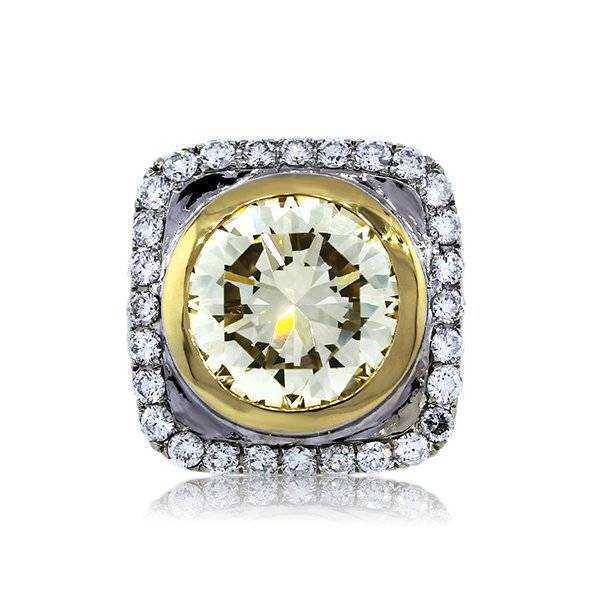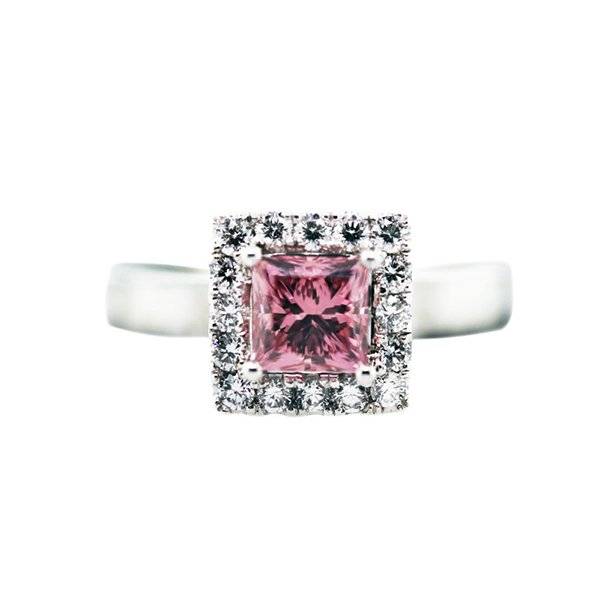Fancy Color Diamond Engagement Rings

Colored diamonds are found in nature and also created in the laboratory. The GIA (better known as the Gemological Institute of America) states that one out of every 10,000 diamonds is colored naturally. There are 27 hues that appear naturally in diamonds, according to the GIA. Pressure and varying degrees of radiation can impact the color of a diamond. Any small defect or imperfection can lead to a colored diamond. The way light refracts through the body of the gem and how it is formed and eventually cut will determine the hue and where it falls on the D-to-Z grading spectrum.
Fancy diamonds are those that have extremely vivid colors, normally found in red, green and blue. A fancy diamond is graded according to laboratory standards. Cut, clarity and color are of the utmost importance when dealing with colored diamonds. The right cut is needed to enhance both the clarity and color of the richly hued gemstones. If the right cut is not used, the color may be dull or lackluster, compared to the brilliance of one that is cut correctly.
Black diamonds – The color of a black diamond has nothing to do with trace elements. Minute deposits of iron and granite provide the black hue. Grey diamonds are normally derived from trace elements of boron, but in some cases, they may be an extremely light black diamond. Careful grading and evaluation is needed to determine the difference.
Brown diamonds – Champagne and cognac are used to describe two of the variations of brown diamonds. Champagne is used to denote a light or pale brown, while cognac signifies a darker, richer hue. It is believed that nitrogen can produce a brown tint to a diamond. Most of the brown color, however stems from minor structural defects in the diamond itself. Light is absorbed by the small defects, distorting the rays of light and producing a brownish color. Brown diamonds are normally found in Africa, Australia and Siberia.
Green diamonds – Extremely rare, green diamonds are difficult to find. It is estimated that ten or less true green diamonds are produced and put on the market each year. Clear diamonds contain billions of molecules of carbon. In a green diamond, it is believed that minute amounts of nickel may be mixed with the carbon atoms to produce the greenish tint. In some cases, it is the radiation that comes from other nearby rocks that cause the green to appear. In cases, where the green is produced by radiation, some of the color may be polished away as the stone is prepared.
Blue and purple diamonds – Blue diamonds are produced when boron and nitrogen are both present. The diamond will take on a deeper blue hue when there is less nitrogen in respect to the boron. Blue diamonds are found mainly in the Cullinan mine in Pretoria, South Africa. While some believe that levels of nickel, boron and hydrogen result in the blue color of many diamonds, the consensus is that it is mostly the mix of boron and minimal amounts of nitrogen.
Purple diamonds are also extremely rare. Mines in Siberia produce almost one percent of all purple diamonds. Professional diamond brokers can tell natural purple diamonds from treated ones due to the color distribution. A naturally colored diamond will have a deep concentration of purple in a specific area along what is known as the deformation lamellae. Synthetically treated purple diamonds are completely saturated with color.
Yellow and orange diamonds – Yellow and orange diamonds are produced when nitrogen mixes with the carbon atoms in various concentrations. Although the orange is considered a modification, the color can saturate evenly throughout the stone. Most yellow diamonds are extremely light in color. Due to their lack of vibrancy, yellow diamonds are not considered to be “fancy” unless their color is enhanced. Mines in South Africa produce the majority of yellow diamonds.
Red and pink diamonds – Red diamonds are the most expensive diamonds. They are exceedingly rare and hard to find. It is believed the red tint is the result of stone’s journey upward through the earth. As the diamond traveled along, the electron structure changed giving the stone a reddish hue.
Pink diamonds are said to be produced in much the same way as stones that are red in color. Located in northwestern Australia, the Arguyle mine produces almost 90 percent of the earth’s pink diamonds. Brazil, India and Tanzinia also produce a modest portion of pink diamonds each year.
Color Grades
Color grades are determined by the GIA. There are three basic characteristics that gemologists look at when determining the value of a colored diamond. The first is the hue of the diamond (pure spectral color). The second is the tone ( the darkness and lightness of the stone’s natural hue). The third is the stone’s saturation of color (neutral to vivid based on the color’s strength and purity).
The GIA has produced the most extensive list and scale of colors in the diamond industry. Along with the 27 main color variations, they also list the different cuts and how they are used to enhance and create a wide range of intensities for each particular color.
Laboratories can add color to almost any diamond with a little work and careful processing. In some cases, a laboratory will add a minute amount of color to enhance or bring out a color that already exists within the diamond. When this occurs it takes an expert in the diamond industry to be able to tell a natural diamond from one that has been altered or enhanced in a laboratory setting. Altering a diamond’s true color and change its value.
Related articles






Comments are closed.